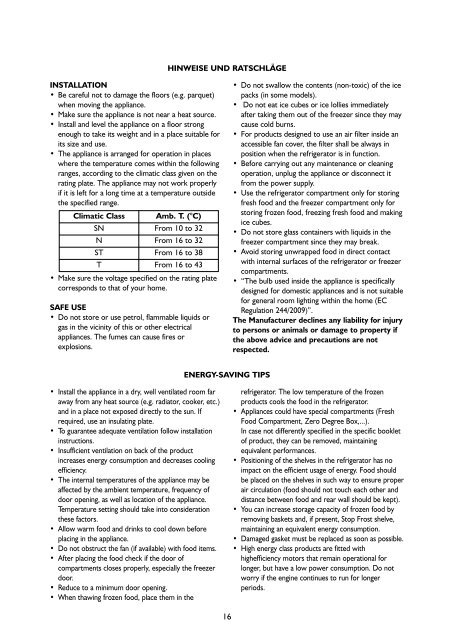KitchenAid U 12 A1 D/HA - U 12 A1 D/HA PT (F093760) Istruzioni per l'Uso
KitchenAid U 12 A1 D/HA - U 12 A1 D/HA PT (F093760) Istruzioni per l'Uso
KitchenAid U 12 A1 D/HA - U 12 A1 D/HA PT (F093760) Istruzioni per l'Uso
You also want an ePaper? Increase the reach of your titles
YUMPU automatically turns print PDFs into web optimized ePapers that Google loves.
HINWEISE UND RATSCHLÄGE<br />
INSTALLATION<br />
• Be careful not to damage the floors (e.g. parquet)<br />
when moving the appliance.<br />
• Make sure the appliance is not near a heat source.<br />
• Install and level the appliance on a floor strong<br />
enough to take its weight and in a place suitable for<br />
its size and use.<br />
• The appliance is arranged for o<strong>per</strong>ation in places<br />
where the tem<strong>per</strong>ature comes within the following<br />
ranges, according to the climatic class given on the<br />
rating plate. The appliance may not work pro<strong>per</strong>ly<br />
if it is left for a long time at a tem<strong>per</strong>ature outside<br />
the specified range.<br />
Climatic Class Amb. T. (°C)<br />
SN From 10 to 32<br />
N From 16 to 32<br />
ST From 16 to 38<br />
T From 16 to 43<br />
• Make sure the voltage specified on the rating plate<br />
corresponds to that of your home.<br />
SAFE USE<br />
• Do not store or use petrol, flammable liquids or<br />
gas in the vicinity of this or other electrical<br />
appliances. The fumes can cause fires or<br />
explosions.<br />
• Do not swallow the contents (non-toxic) of the ice<br />
packs (in some models).<br />
• Do not eat ice cubes or ice lollies immediately<br />
after taking them out of the freezer since they may<br />
cause cold burns.<br />
• For products designed to use an air filter inside an<br />
accessible fan cover, the filter shall be always in<br />
position when the refrigerator is in function.<br />
• Before carrying out any maintenance or cleaning<br />
o<strong>per</strong>ation, unplug the appliance or disconnect it<br />
from the power supply.<br />
• Use the refrigerator compartment only for storing<br />
fresh food and the freezer compartment only for<br />
storing frozen food, freezing fresh food and making<br />
ice cubes.<br />
• Do not store glass containers with liquids in the<br />
freezer compartment since they may break.<br />
• Avoid storing unwrapped food in direct contact<br />
with internal surfaces of the refrigerator or freezer<br />
compartments.<br />
• “The bulb used inside the appliance is specifically<br />
designed for domestic appliances and is not suitable<br />
for general room lighting within the home (EC<br />
Regulation 244/2009)”.<br />
The Manufacturer declines any liability for injury<br />
to <strong>per</strong>sons or animals or damage to pro<strong>per</strong>ty if<br />
the above advice and precautions are not<br />
respected.<br />
ENERGY-SAVING TIPS<br />
• Install the appliance in a dry, well ventilated room far<br />
away from any heat source (e.g. radiator, cooker, etc.)<br />
and in a place not exposed directly to the sun. If<br />
required, use an insulating plate.<br />
• To guarantee adequate ventilation follow installation<br />
instructions.<br />
• Insufficient ventilation on back of the product<br />
increases energy consumption and decreases cooling<br />
efficiency.<br />
• The internal tem<strong>per</strong>atures of the appliance may be<br />
affected by the ambient tem<strong>per</strong>ature, frequency of<br />
door opening, as well as location of the appliance.<br />
Tem<strong>per</strong>ature setting should take into consideration<br />
these factors.<br />
• Allow warm food and drinks to cool down before<br />
placing in the appliance.<br />
• Do not obstruct the fan (if available) with food items.<br />
• After placing the food check if the door of<br />
compartments closes pro<strong>per</strong>ly, especially the freezer<br />
door.<br />
• Reduce to a minimum door opening.<br />
• When thawing frozen food, place them in the<br />
refrigerator. The low tem<strong>per</strong>ature of the frozen<br />
products cools the food in the refrigerator.<br />
• Appliances could have special compartments (Fresh<br />
Food Compartment, Zero Degree Box,...).<br />
In case not differently specified in the specific booklet<br />
of product, they can be removed, maintaining<br />
equivalent <strong>per</strong>formances.<br />
• Positioning of the shelves in the refrigerator has no<br />
impact on the efficient usage of energy. Food should<br />
be placed on the shelves in such way to ensure pro<strong>per</strong><br />
air circulation (food should not touch each other and<br />
distance between food and rear wall should be kept).<br />
• You can increase storage capacity of frozen food by<br />
removing baskets and, if present, Stop Frost shelve,<br />
maintaining an equivalent energy consumption.<br />
• Damaged gasket must be replaced as soon as possible.<br />
• High energy class products are fitted with<br />
highefficiency motors that remain o<strong>per</strong>ational for<br />
longer, but have a low power consumption. Do not<br />
worry if the engine continues to run for longer<br />
<strong>per</strong>iods.<br />
16
















